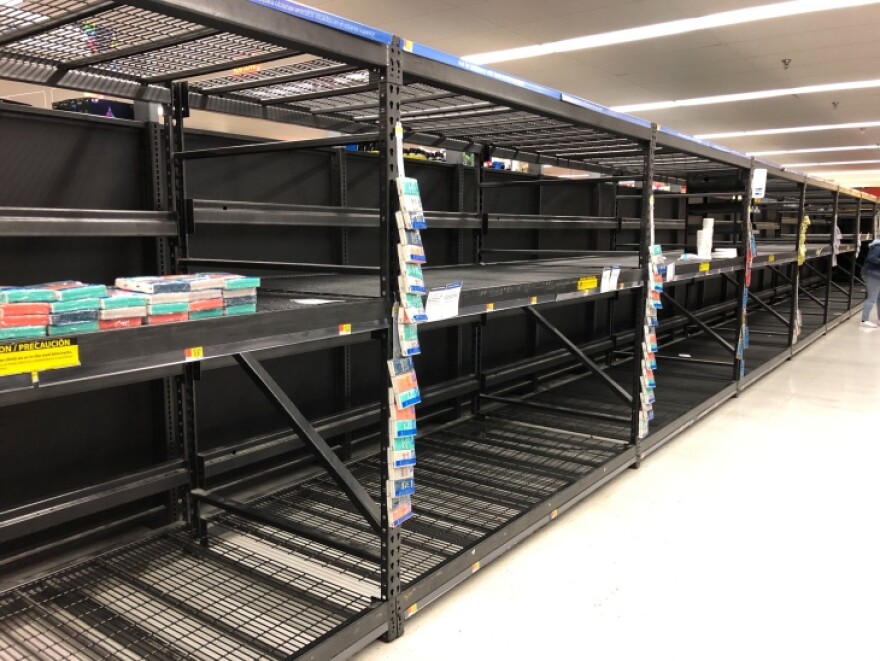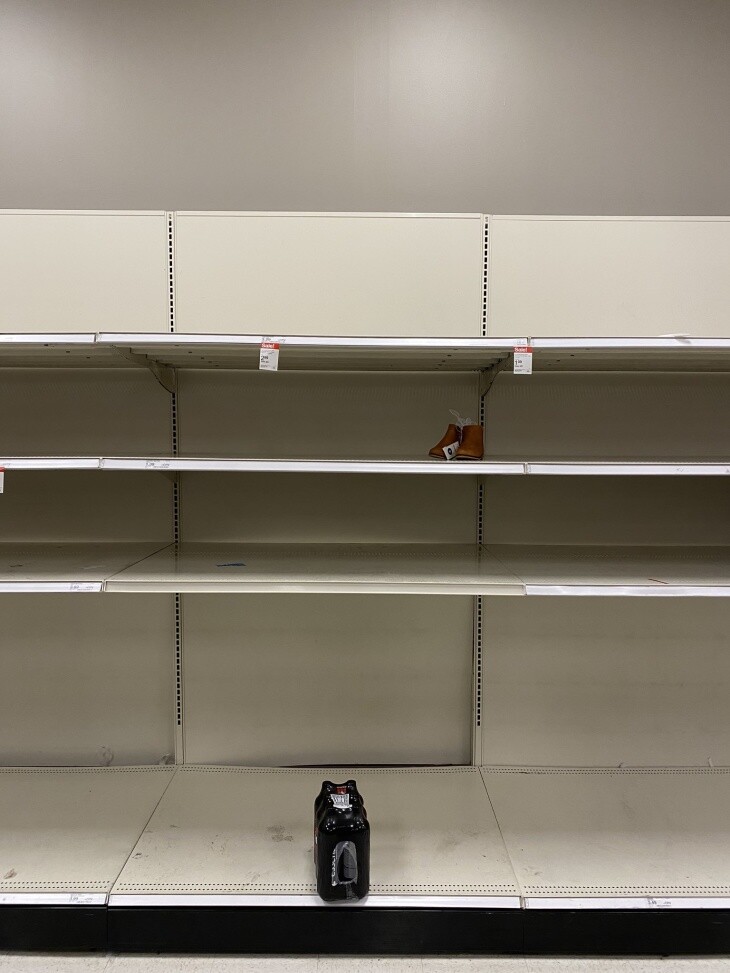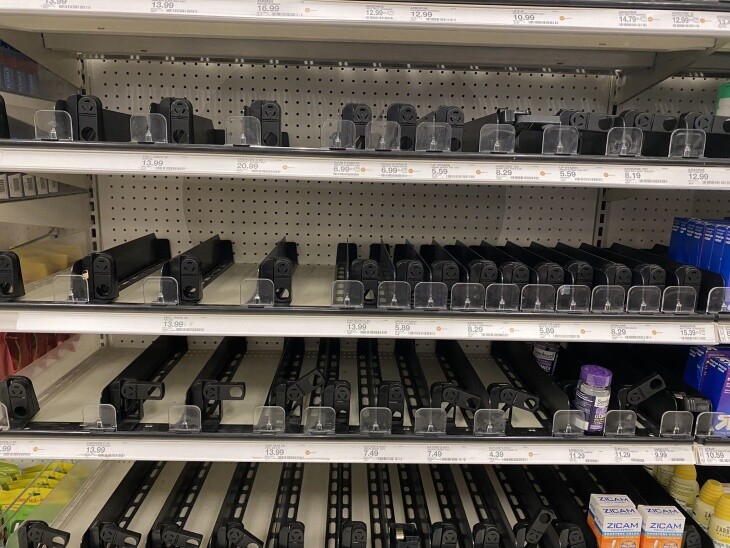Truth matters. Community matters. Your support makes both possible. LAist is one of the few places where news remains independent and free from political and corporate influence. Stand up for truth and for LAist. Make your year-end tax-deductible gift now.
Your No-Panic Guide: The Supply Chain Is Fine. So When Will Everything Be Back In Stock?

If you've been to or near a grocery store (in affluent areas at least) you've seen the evidence of full-on panic buying.
Lines out the door of Costco and Trader Joe's, even though the government recommends people stock up on just two weeks worth of supplies. Shelves normally packed with everything from toilet paper to bread are empty. Freezers full of frozen spinach and blueberries have been left bare.
The real heroes here are the staff members at all of the grocery stores, Costcos, targets, etc... 👏🏽 #hangintherefolks #youtherealMVP #coronapocalypse #TraderJoes pic.twitter.com/RBdAsnHqAa
— Britni Lopez (@britnilopez) March 13, 2020
When we asked the California Grocers Association last week about what they were seeing they told us:
"The demand for some products has made it a challenge to distribute goods fast enough to restock shelves as quickly as consumers are purchasing them."
And that has remained true, with meat and other staples like eggs either not available or rationed.
The sustained panic-buying prompted Los Angeles Mayor Eric Garcetti to bring out a cadre of grocery store representatives from across the industry at a news conference on March 16.
Hoarding food, he cautioned, "has a consequence" for vulnerable people and -- this is key -- is also unecessary. Garcetti said there is plenty of food, and toilet paper and paper towels will be replenished quickly.
"Supply chains are completely uninterrupted, and there's no shortage of food," he said. "There's no reason to make a run on the supermarkets. Hoarding is hurting our most vulnerable Angelenos."
Clearly, the fear caused by the unfettered spread of this virus has been a stress on the supply chain.
So we wanted to do a reality check on when everything be back in stock.
Stick with us, because in some cases the answer may be:
¯\_(ツ)_/¯
But as this big surge in buying levels out, we should see items back in stores over the next few weeks.
We do know that as of Friday, Port of Los Angeles officials -- who run the nation's busiest port -- said that all terminals are open, cargo is moving at 85% of normal traffic and they'd identified no COVID-19 cases.
But when it comes to specific products, it's difficult to give hard timelines.
It's highly dependent on what the product is, the company behind it, as well as the vast ecosystem that moves it from raw material to bouncing along on a truck to finally perched on your shelf.
I spoke with both Willy Shih, Professor of Management Practice at Harvard Business School and Miguel Gomez, Professor at the Dyson School of Applied Economics and Management at Cornell University -- who've studied supply chains -- and they had a few thoughts.
TOILET PAPER

Demand for toilet paper is generally pretty stable, which makes it even more likely to be out of stores for some time.
"It's not like [manufacturers] have a lot of surge capacity they can suddenly bring on. They can maybe work a little bit longer, but most of those plants run 7 by 24 anyways," said Shih.
DON'T MISS ANY L.A. CORONAVIRUS NEWS
Get our daily newsletter for the latest on COVID-19 and other top local headlines.
Terms of Use and Privacy Policy
Also, toilet paper is bulky and costs a lot to store and ship, which is why it's manufactured near the markets that consume it. As such, the capacity of those facilities is sized to demand, meaning there's not a lot of flexibility in production or extra TP in storage.
However, at some point people are going to realize that a family can only go through so much toilet paper, and that symptoms of coronavirus virus won't necessarily require you to use more. If you panic buy a three year supply, you might not go out and buy it for some time.
So it's a difficult balance for manufacturers -- how much to increase production without having excess product on their hands when demand drops.
MEDICINE

Acetaminophen (Tylenol) is a different story.
(Update 3-18-20: There's an ongoing debate about the use of ibuprofen to help counteract fevers associated with COVID-19. We've got more information about that in our no-panic guide. To read more, go to the section: SHOULD I NOT TAKE IBUPROFEN?)
Demand is and could very well stay high, as it's recommended that people with fevers associated with the virus take the medications to help control their temperatures.
Johnson and Johnson, the manufacturers of Tylenol, responded to LAist queries and said that they've ramped up production at their facilities in Pennsylvania and Puerto Rico.
"They're running flat out, 24/7, to manufacture. This is just one of those situations where the demand peaked very quickly and we need to move as quickly to keep up with the level of demand," said Kathleen Widmer, Company Group Chairman, North America Consumer.
In an effort to get product on shelves as quickly as possible, they've focused on manufacturing the easiest to produce pills, the white ones with red writing on them. As such, you might not see the full range of their products available.
"If we focus on a couple of high-demand consumer items, we're going to be much better at keeping up with demand than if we try to fulfill every single item that sits on the shelf," said Widmer.
Shih and Gomez both pointed out that these sorts of medicines were fairly easy to produce and ship - teenie tiny pills don't take up much space -- so the ramp up in response from manufacturers could end up meeting demand.
A problem could be holdups in supply chains out of China and India, where ingredients and pharmaceuticals are often manufactured. If so, there'll likely be a lag in the supply chain that could be felt in a few weeks time.
Widmer said that Johnson & Johnson weren't experiencing any supply chain issues at this time.
CLEANING SUPPLIES
Cleaning supplies, hand sanitizer and soap are also items that are and will remain in high demand, stressing the system. But they're more difficult than medications to get to the consumer.
"The process of manufacturing soap is a little bit more complicated. And distributing soap is not as easy as distributing over-the-counter medication," said Gomez. Bottling, packaging and shipping the bulky items can be more cumbersome than tiny pills.
Manufacturers have to decide whether to just ramp up production using existing infrastructure or to invest in new facilities -- which would take additional time, and may not pay off when demand dies down.
Purell, a hand sanitizer manufactured by Gojo Industries, has been notoriously difficult to get a hold of.
"We have experienced several demand surges in the past during other outbreaks -- and this is on the higher end of the spectrum but not unprecedented," Gojo Industries spokesperson Samantha Williams told Business Insider. She said they've increased production.
Gomez thinks that it'll take a bit more time to see these products on shelves than the medicines.
FOOD

Fresh foods, like fruits and vegetables, don't store long and often come from far off locations. Whether we'll see, say, pineapples disappear from our stores, depends on whether coronavirus takes a bite out of that part of the supply chain.
Dried foods like beans and rice are a bit different, as they store for a while. They're also able to keep through multiple seasons, which means that there's inventory already out in the world, waiting to be distributed.
There are a ton of food manufacturers, so hopefully that supply chain will pick up to meet grocer demand.
"Grocers continue to monitor product availability up and down the supply chain," said the Grocers Association in a statement. "During these anxious times, it's important our communities remember we are all in this together -- customer and employee safety is paramount to ensure Californians can access the products they need.
Let us know if there's one particular item you can't get a hold of. We'd love to look into it.
PLEASE BE CONSIDERATE
In a time when we all need to be supporting one another, those who didn't get around to or were unable to stock up -- possibly for monetary reasons -- could be left scrounging the aisles for any remaining bottle of cough medicine or bag of rice for some time while supplies replenish.
Be considerate.
"What I've been telling people is, really, the answer is you've got to ration this," said Shih. "When people go out and come into the store and try to buy what is obviously a two year supply, it's like, show a little consideration for your neighbors. Because you're not going to use that all in the next two months. Leave that for some other people."
This article was originally published on March 14. It has been updated with new information.
SOME STRAIGHT TALK ABOUT COVID-19
We're all living through this extraordinary and frightening pandemic. The vast majority of our newsroom has been working from home (here's some advice on that) since March 11 to bring you calm, helpful reporting. We are answering your questions and taking more.
LAist is known for our events listings but now hopefully we'll be known for our non-event listingsand tips for parents to try to keep you sane. And we're looking for your nominations for everyday heroes in this time of crisis. We're here to help. And if you can help support that effort financially, we'd be grateful.








